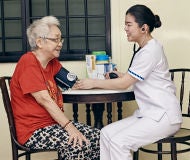Introduction
The purpose of a cytological examination is generally for the cytological detection of malignancy. Cytology laboratory offers screening of cervical-vaginal samples and the interpretation of non-gynecological and fine needle aspiration (FNA) specimens with the ultimate goal of attaining the most accurate and complete diagnosis possible.
The goals of the service include:
- To maintain excellence in specimen preparation and diagnostic accuracy
- To provide the highest quality consultative services to our clinical colleagues, both within our institution and elsewhere
- To train residents, fellows, medical students and cytotechnologists in diagnostic cytopathology
- To support and incorporate advanced diagnostic techniques to improve diagnostic accuracy
Range of Laboratory Services
Services provided by the laboratory include:
- Gynaecological Cytology (Liquid-based Gynaecological Cytology)
- CINTec Plus Cytology Immunocytochemistry Staining on Liquid-based Gynaecological Cytology
- Non-Gynaecological Cytology (e.g., sputum, urines, peritoneal/ pleural fluid, BAL)
- Fine Needle Aspiration Cytology from Various Superficial and Deep Tissues
- Identification of infections and associated organisms including bacteria, fungi, protozoa and viruses (special stains may be used to aid in the detection of these organisms)
- Evaluation of joint aspirates for crystals
- Detection of the presence of Demodex in Eyelashes
- Broncho-alveolar Lavage Differential Cell Count
- Sputum Cell Count
- ROSE (Rapid On-Site Evaluation) for specimen adequacy, at
- Division of Vascular & Interventional Radiology (FNA/Biopsy)
Available Monday to Friday (except PH); 8:30am to 4:30pm. - Ambulatory Endoscopy Centre (FNA)
Available Monday to Friday (except PH); 8:30am to 4:30pm. - Inpatient and Lung Endoscopy Centre (FNA)
Available Monday to Friday (except PH); 8:30am to 4:30pm. - National Cancer Centre Singapore (FNA)
Available Monday to Friday (except PH); 8:30am to 5:00pm. Booking is required. Please contact 9177 8608 to schedule FNA appointment. Otherwise, please contact cytology laboratory at 6576 7587 for any enquires. - Diabetes and Metabolic Centre (FNA)
Available Monday, Tuesday and Friday; 8:30am to 5:00pm. - Specialist Outpatient Clinics (FNA)
Available Monday to Friday (except PH); 8:30am to 5:00pm. Please contact 8125 3479 to schedule an FNA appointment. Otherwise, please contact cytology laboratory at 6576 7587 for any enquires.
- Division of Vascular & Interventional Radiology (FNA/Biopsy)
Other services available :
- One-Stop Thyroid FNA ReportingCases will be reported within a few hours of receipt. Please contact cytology laboratory in advance at 6576 7587 for details.
- One-Stop Breast FNA Cytology Clinic
Cases will be reported within a few hours of receipt. Please contact cytology laboratory in advance at 6576 7587 for details.
Special Instructions on Specimen Collection and Handling
Please refer to following sections for site-specific instructions:
A. Gynaecological Cytology
B. Non-Gynaecological Cytology
C. Fine Needle Aspiration (FNA)
D. Fluid (sputum, urine, peritoneal/ pleural fluid, BAL, CSF and vitreous fluid)
E. BAL differential cell count and sputum cell count
F. Demodex detection in eyelashes
(A) Gynaecological Cytology
The cervical (Pap) smear is a screening technique to aid in the detection of cancer and cancer precursors of the uterine cervix. It is not a diagnostic procedure. Both false-negative and rarely, false-positive results have been experienced with Pap smears. Accordingly, any lesion detected on screening should be biopsied. The Pap smear should not be used as the sole means to diagnose or exclude malignant and premalignant lesions.
1. CPOE Request
With effect from 7 September 2016, all specimens are to be submitted with CPOE requests and labelled with their respective CPOE labels. Ordering clinicians are reminded to save the order at the end of entry to ensure proper submission of the CPOE request. Submit one request for the same patient at the same operation, irrespective of the number of specimens taken. In the event that CPOE system is not available, test request forms should be submitted. The request must include:
- Patient’s name, age and identification number
- Submitting physician's name and contact number
- Date of specimen collection
- Source of material submitted (cervical, endocervical, vaginal, other body site)
- Last menstrual period (LMP)
- Hormonal status (e.g. post-menopausal, gravid)
- Exogenous hormone therapy (including birth control pills, treatment for endocrine-responsive malignancy, estrogen creams)
- Use of intrauterine device (IUD)
- DES exposure
- History of abnormal cytology and gynaecological disorders
- History of systemic chemotherapy, pelvic radiotherapy, gynaecologic surgery, cryosurgery, electrocautery, or laser surgery
- Any current abnormal clinical findings or patient symptoms; and
Risk factors for cervical cancer (e.g., multiple sexual partners, sexually transmitted diseases including human papillomavirus [HPV], sexual activity at an early age, and smoking) if obtainable.
It is imperative that these instructions be strictly adhered to, omission of which may result in delay of reporting.
Please note that PAP smear specimens that have been processed by Cytology Lab can NOT be forwarded to Molecular Lab for HPV DNA test.
2. Patient Preparation
- Ideal sampling date is two weeks after the first day of the LMP
- Discourage sampling during normal menses
- Avoid use of vaginal medication, vaginal contraceptives, or douches for 48 hours prior to examination.
3. Collection Procedure
Broom-Like Device Protocol - extracted from Hologic Publication
 |
1. Obtain an adequate sampling from the cervix using a broom-like device. Insert the central bristles of the broom into the endocervical canal deep enough to allow the shorter bristles to fully contact the ectocervix. Push gently, and rotate the broom in a clockwise direction five times. |
 |
2.Rinse the broom as quickly as possible into the PreservCyt Solution vial by pushing the broom into the bottom of the vial 10 times, forcing the bristles apart. As a final step, swirl the broom vigorously to further release material. Discard the collection device. |
 |
3. Tighten the cap so that the torque line on the cap passes the torque line on the vial. Label the specimen vial with the CPOE sticky label. Avoid double labelling the specimen.
|
Note: Under no circumstances should the speculum be lubricated with medical jelly as it can make the Pap test unsatisfactory.
Endocervical Brush/ Spatula Protocol - extracted from Hologic Publication
 |
1. Obtain an adequate sampling from the ectocervix using a plastic spatula. |
 |
2. Rinse the spatula into the PreservCyt Solution vial by swirling the spatula vigorously in the vial 10 times. Discard the spatula. |
 |
3. Obtain an adequate sampling from the endocervix using an endocervical brush device. Insert the brush into the cervix until only the bottom most fibers are exposed. Slowly rotate ¼ or ½ turn in one direction. DO NOT OVER-ROTATE. |
 |
4. Rinse the brush in the same vial of PreservCyt Solution by rotating the device in the solution 10 times while pushing against the PreservCyt vial wall. Swirl the brush vigorously to further release material. Discard the brush. |
 |
5. Tighten the cap so that the torque line on the cap passes the torque line on the vial. Label the specimen vial with the CPOE sticky label. Avoid double labelling the specimen. |
Note: Under no circumstances should the collection device be lubricated as it can make the Pap test unsatisfactory.
4. Quality Indicators
Smear Adequacy
A satisfactory liquid-based ThinPrep preparation should show a minimum of 5,000 well-visualized/preserved squamous cells. If fewer than these are seen because of paucity of cells, poor fixation, air-drying artefact, thick smearing, or covering of blood, inflammatory exudate (with >75% of cells obscured) or other contaminants, the smear is considered unsatisfactory. A smear comprising mainly endocervical cells is also considered unsatisfactory, unless the smear was intended to specifically evaluate the endocervical canal.
(B) Non-Gynaecological Cytology
General Instructions
All primary containers must be clearly labelled with at least two patient-specific identifiers, e.g. Patient’s NRIC/passport/work permit number or other acceptable identifier which includes, but is not limited to: patient name or date of birth. In the case of prepared smears, all glass slides must be clearly labelled with the patient’s NRIC number and patient’s name. In the event that more than one site is aspirated, the site must be clearly indicated on each slide.
CPOE Request
With effect from 7 September 2016, all specimens are to be submitted with CPOE requests and are to be labelled with their respective CPOE labels. Submit one request for the same patient at the same procedure, irrespective of the number of specimens taken. Ordering clinicians are reminded to check the following boxes to finalise the CPOE order to prevent delays in specimen processing:
- Specimen label completed
- Vetted and order form completed (Dr only)
In the event that CPOE order is not available, hardcopy histopathological investigation request forms should be submitted. The request forms must include:
- Patient’s name, age, sex and identification number
- Patient’s exact location (hospital/department/clinic/ward/bed)
- Submitting physician’s name, MCR number and telephone number
- Consultant-in-charge’s name and MCR number
- Time and date of collection
- Source of specimen/anatomic site sampled
- The number and type of specimens submitted (containers of fluid, slides, etc.)
- Test requested
- Relevant clinical findings and history, including operative findings, previous laboratory accession number or date of previous operation
- Provisional clinical diagnosis
Specimens that require urgent reporting should be delivered immediately by hand to the cytology laboratory. The request should be indicated in the CPOE request.
If additional tests (e.g.: immunocytochemistry, molecular, FISH) are to be done after a case has been reported, a new CPOE request has to be submitted. The CPOE label for the new request has to be sent to the laboratory (via porter or pneumatic tube). The request must include:
- Source of specimen/anatomic site sampled
- The number and type of specimens submitted (containers of fluid, slides, etc.)
- Test requested (under the special instructions tab)
- Relevant clinical findings and history, including operative findings, previous laboratory accession number or date of previous operation
- Provisional clinical diagnosis
(C) Fine Needle Aspiration (FNA)
Smear Preparation
- Label all slides with patient’s NRIC (full NRIC, last 4 digits not accepted) and initials on the frosted end of the slides using a hard lead pencil.
- If more than one site is sampled, it is mandatory to indicate clearly the site sampled on each slide and slide container.
- Aspirate the specimen onto the slide with the frosted end. Prepare 1 air-dried and 1 spray/alcohol-fixed smears per pass; rinse any remaining material into Cytolyt solution or formalin for ancillary tests if necessary. Indicate in the CPOE order the solution used and the fixation start time (for formalin).
- Submit a maximum of 2 passes (4 slides: 2 air-dried and 2 spray/alcohol-fixed) from each site.
- Alcohol-fixed smears should be fixed immediately with cytology spray fixative or immersed in 95% ethanol before air-drying occurs.
- Place slides in a slide holder (mailer) labelled with CPOE label, with the frosted side that the specimen is aspirated on facing away from the other slide (slides are back to back).
Cyst or Abscess
- If fluid is aspirated (e.g. from a cyst or abscess), aspirate the specimen directly into a sterile specimen bottle.
- Do not use swab sticks as the specimen will dry up.
Bile duct or bronchial brushing
- Rinse and place the brush tip in Thinprep Cytolyt solution (contact cytology laboratory at 6576 7587 for collection of Thinprep Cytolyt solution).
Needle-rinse Formalin for cell block
- It is recommended to take additional passes for specimens that require ancillary tests such as immunochemistry tests, SSTP and EGFR.
- Specimens are to be fixed in 10% neutral phosphate-buffered formalin for at least 6hrs and up to 72hrs at room temperature.
- The specimen must be fully submerged with formalin to approximate specimen volume of 10:1 or higher.
- The type of solution used (preferably formalin) and fixation start time should be clearly indicated in the CPOE request.
(D) Fluid (sputum, urine, peritoneal/ pleural fluid, BAL, CSF and vitreous fluid)
- A maximum volume of 300mL of fluid, in an aliquot of 50 mL may be sent to the laboratory. If delay is anticipated, store the specimen at 4ºC.
- Ensure that all specimen bottles are tightly capped and labelled with the CPOE labels.
- Fluid in larger containers (e.g. 5L bottles, drip bags etc.) will NOT be accepted.
- CSF and vitreous fluid degenerate within one hour, even with refrigeration. It should be collected in Shandon fixative (CSF, pictured below) and Preservcyt (vitreous fluid), and despatched as soon as possible. Please contact cytology laboratory at 6576 7587 or email cytology@sgh.com.sg in advance before sending a porter to the laboratory to collect the fixatives.
- CSF in other fixatives such as Transfix and EDTA are not accepted.

(E) BAL and Sputum for Differential Cell Count
- BAL differential cell count: It is recommended to submit a minimal volume of 5 mL, optimally 10 to 20 mL of a pooled BAL sample.
- Specimens for differential cell count should be transported at 4°C (on ice) to the laboratory immediately (within 1 hour of collection). Specimens should NOT be transported frozen or on dry ice.
- Ensure that all specimen bottles are tightly capped and labelled with the CPOE labels.
- Indicate in the CPOE order that specimen is for “differential cell count” and ensure that the order is vetted and completed to avoid delay in specimen processing.
- A separate specimen and CPOE order should be sent to the laboratory if routine cytology is also required.
(F) Eyelashes for Demodex Investigation
- Label 2 microscope glass slides with patient’s NRIC and name on the frosted end of the slides with a hard lead pencil. Alternatively, the slide can be labelled with the CPOE label.
- Place eyelashes in between the 2 microscopic slides, in the centre.
- Tape both short ends of the microscopic slides to ensure the eyelashes are secure.
- Place slides in a slide container labelled with patient’s CPOE labels.



















